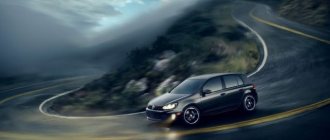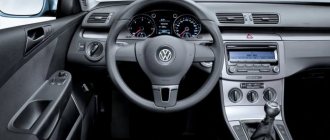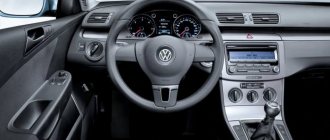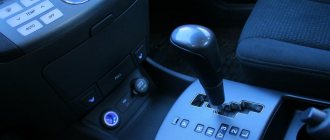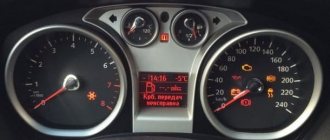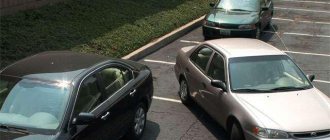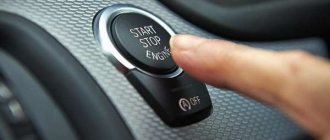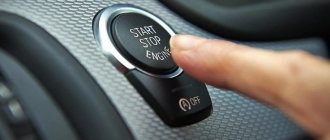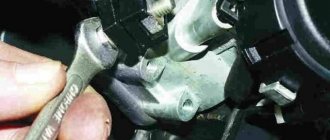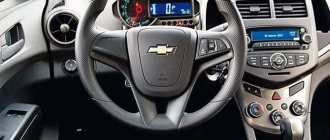For novice drivers, the greatest difficulties are caused by the technique of overtaking and parking. Also of particular importance is the question of how to turn correctly when cornering. In this article we will look at techniques for turning a car .
Moving a car involves performing various driving techniques and maneuvers, which include the so-called turn. To learn how to turn correctly when turning, you need to master the turning technique.
The correct turn is characterized by accuracy, speed, safety, which is accompanied by an appropriate response from the driver in certain driving conditions and is performed in accordance with established traffic rules.
Technique for turning a car
Mastering the turning technique involves learning four basic techniques:
- Driving along a straight road - that is, approaching a turn;
- Directly entering a turn , which is accompanied by turning the steering wheel;
- Car movement in a turn;
- Exiting a turn is accompanied by the driver returning the steering wheel to its original position.
The correct turn of the car is influenced not only by the speed and trajectory of the car during the turn, but also by the operating mode of the engine.
Trajectory
If the goal is to achieve the best lap time, you need to make the most of the road width. To go through a turn as quickly as possible, you need to move along the smallest radius from the entry point to the exit point. In other words, at the entry point you begin to turn towards the apex, after passing the apex you need to begin straightening, which ends at the point of exit to the straight line. This is the description of the ideal trajectory when driving on a race track. But there are extreme situations in which the trajectory of movement undergoes changes to obtain benefits:
- late entry. In this case, the apex moves towards the outer edge of the turn, and therefore, when moving towards the apex, the trajectory is more straightforward. A late apex allows you to begin straightening earlier, and, consequently, acceleration. This gives a significant advantage if there is a long straight section around the bend;
- early entry. Cutting the entry arc is used when overtaking an opponent on the track. The driver starts braking later, heading towards the apex at a greater angle, therefore covering less distance. This allows you to block the opponent's ideal trajectory and forces him to move to the outer edge of the turn.
If the road bend has a complex shape, there may be several apexes in the arc.
Vehicle speed when turning
Before entering a turn, you must reduce the vehicle speed. It should be remembered that while the car is passing through an arc, it is necessary to maintain a constant speed.
The safety of turning depends on the vehicle turning correctly. To make a safe turn, you should begin to reduce speed on a straight section of the road well before the turn, which eliminates the effect of wheel slipping and the possibility of the car skidding when turning.
We briefly looked at what you need to consider when approaching a turn - speed and trajectory. And now in more detail about the driver’s actions when entering a turn, driving in a turn and exiting a turn.
City traffic
When driving on public roads, the main responsibility of every driver is to ensure their own safety, as well as the safety of other road users. Therefore, it would be wrong to talk about a sharp, sporty driving style and high-speed cornering. The technique of cornering in the city, as well as on country roads, requires the implementation of only 2 rules:
- You need to stay within your lane. Most likely, you have seen a picture where drivers, turning at an intersection, cut the corner. This situation is extremely unsafe, as traffic trajectories intersect. In other words, the turning driver partially enters the oncoming lane. Of course, this reduces the braking distance for drivers moving towards a turning car;
- the speed must be appropriate to the road conditions. For drivers with a manual transmission, it is important to engage the gears before turning. You need to enter a turn at a speed that can be maintained in the arc without the risk of the car drifting or skidding. In order not to have to use the skills to react to a skid or drift, you do not need to sharply slow down or accelerate when turning (this is most true in the winter season and rainy conditions, when the road surface is extremely slippery). Particular attention should be paid to “closed” long turns or areas that are not fully visible when the maneuver begins. In both cases, the driver does not have the opportunity to assess the situation at the end of the turn, and therefore the speed must be an order of magnitude lower. In this case, the driver leaves himself the opportunity to react in time to the sudden appearance of an obstacle on the road.
Correct entry of the car into a turn
So, correct entry into a turn implies an early reduction in speed before the turn, which will ensure that the turn is passed at a reduced speed. The vehicle speed before turning should be selected depending on the turning conditions and the condition of the road section. In unfavorable road conditions, in the presence of possible additional obstacles, the speed when turning should be significantly reduced.
Before the car enters a turn, you should pay attention to the point of fixation of attention and the position of your hands on the steering wheel.
When turning, the driver's attention should be directed to the exit point of the turn (that is, the driver must imagine the final picture of the turn, its result).
If the driver is unable to view and visualize the result of the turn, or visibility is obstructed, measures should be taken to reduce the vehicle speed as much as possible before the turn.
Common mistakes
The most common mistake that can end in disaster is speeding when cornering. Too much speed leads to loss of control, the car begins to throw, and as a result is thrown off the road. On a slippery road, a car may simply refuse to turn and fly straight into the bushes on the side of the road. To avoid this, it is better to play it safe and slow down to a minimum than to get into an accident. It’s not for nothing that bikers have a saying “if you can go at a certain speed, then it’s better to go 2 times slower.”
Another common mistake
is an attempt to play with the pedals and gear lever right in the turn. If you squeeze the clutch, the relationship between the engine and the wheels is disrupted, which leads to a decrease in the controllability of the car. In cornering conditions, this can lead to complete loss of control. Pressing the brake pedal in a car with an automatic transmission works in exactly the same way, only in this case there is also a risk of skidding. Any impact on the brake pedal while the wheels are turned can lead to skidding of the rear axle.
Sometimes, beginners make mistakes when working with the steering wheel. You don't want to go into a turn at too steep an angle, unless that's the only way to get into the turn. The best way to enter a turn is to turn the steering wheel smoothly. When turning right, your hands should be at the 8 and 12 o'clock positions on the steering wheel. If we turn left, then at 4 and 12. This will allow you to control the steering wheel with maximum efficiency. You should not make sudden movements; you should enter the turn in a gentle arc. It is forbidden to hitch into the oncoming lane. If oncoming traffic appears there, it will be very difficult to avoid a collision. It is also not recommended to drive along the side of the road, especially at high speed. It's all about the different coefficient of road grip; if one wheel has this indicator reduced, then there is a possibility of losing control of the car.
Conclusion
. Every year hundreds of young drivers take to the roads. Unfortunately, training in driving schools is far from ideal. Therefore, beginners are left with many questions. One of them is how to properly enter a turn with a manual or automatic transmission. In fact, there is not much difference in cornering here. But, there are some differences in the process of driving a car, which, in principle, can affect cornering. It is advisable for the driver to know all these nuances.
Diagram of the correct turn of the car
- Before turning, the driver smoothly depresses the brake pedal to reduce speed (if necessary, a lower gear can be used).
- Determining the vehicle's trajectory. The steering wheel is turned with both hands, according to the grip pattern.
- The driver's gaze is fixed on the point where the car exits the turn. When the car passes through a turning arc, a constant speed is maintained.
- Exiting a turn is accompanied by the steering wheel returning to its original position and a smooth increase in vehicle speed.
A novice driver must practice the technique of making turns Over time, drivers become overconfident when making various difficult turns, which can affect driving safety. Don’t take risks, control yourself, follow the technique of making turns. Bring the correct technique for performing a turn to automaticity. Have a safe ride.
From which lane is a left turn allowed?
First, let's look at the most ordinary intersection, where there are no signs or markings that determine the directions of traffic along the lanes:
In this case, the choice of lane is regulated by paragraph 8.5 of the traffic rules:
8.5. Before turning right, left or making a U-turn, the driver is obliged to take in advance the appropriate extreme position on the roadway intended for traffic in this direction, except in cases where a turn is made when entering an intersection where a roundabout is organized.
Thus, turning is only allowed from the left lane. Moreover, you need to not only take the left lane, but also the extreme left position on this lane (the white car in the picture above). That is, the car should be located as close as possible to the markings separating the oncoming direction.
You need to understand that turning left from the right lane will entail a fine of 1,000 - 1,500 rubles:
Penalty for turning from the wrong lane
Turn left from two lanes
In the traffic rules, there are special signs and markings that allow you to establish a different order of traffic on the lanes. If there are such signs and (or) markings, a left turn can be made from several lanes:
In the figure above, signs 5.15.2 allow you to turn left from both the left lane and the middle lane. Usually this situation does not cause problems for drivers. The white car turns into the left lane, and the orange car turns into the right. That is, the trajectories do not intersect.
However, if you carefully study the text of the traffic rules, you will notice ambiguity. On the one hand, paragraph 8.5 requires you to take the extreme left position before turning left. On the other hand, signs 5.15.2 allow turning from two lanes. Moreover, the rules do not say that if signs 5.15.2 are present, clause 8.5 ceases to apply. That is, if we take the traffic rules literally, it turns out that the use of signs allowing simultaneous turns from several lanes is meaningless, because Drivers must still only turn from the left lane. However, in practice, there is no fine for turning from the middle lane if there is a sign 5.15.2 allowing a turn.
In practice, questions may arise in the event of an accident while turning left at the same time. Since the situation is not regulated by other clauses of the rules, clause 8.9 applies:
8.9. In cases where the trajectories of vehicles intersect, and the order of passage is not specified by the Rules, the driver to whom the vehicle is approaching from the right must give way.
That is, the orange car is on the right and has the right of way, and the white one must give way to it.
Turn left from tram tracks
The intersections through which tram tracks run at the same level as the asphalt deserve special attention:
The situation is regulated by the second paragraph of clause 8.5 of the traffic rules:
If there are tram tracks in the same direction on the left, located at the same level as the roadway, a left turn and a U-turn must be made from them, unless signs 5.15.1 or 5.15.2 or markings 1.18 prescribe a different movement order. In this case, there should be no interference with the tram.
That is, in the example above, the white car can turn left only from the passing tram track. The situation is discussed in more detail in the article:
Selecting a lane before an intersection with tram tracks
What is an automatic transmission
An automatic transmission is one of the types of transmission in which the required gear ratio is automatically selected without driver intervention, taking into account the nature of the movement, speed and other parameters.
In a car with an automatic transmission, there is no clutch pedal due to the fact that the clutch is replaced by a torque converter, which transmits torque to the wheels.
Starting a car with automatic transmission
To ensure the safety of the automatic transmission, several types of protection are provided in the car.
What not to do with automatic transmission
Despite the fact that an automatic transmission seems easy to operate and is designed to make driving easier, there are still restrictions and prohibitions, adhering to which, the automatic transmission will last a long time and without complaints.
Restrictions and prohibitions when driving with an automatic transmission:
Manufacturers have provided a long service life for automatic transmissions, but subject to certain rules.
If you do not adhere to them, then the time to repair the automatic transmission will get closer with each incorrect action. Repairing an automatic transmission is an expensive pleasure.
Source
How to drive an automatic transmission correctly - tips for driving a car with automatic transmission
Currently, more and more cars are coming off the assembly line equipped with an automatic transmission. The thing is that in city mode with traffic jams and constant stops at traffic lights, an automatic transmission is very convenient, saving a lot of nerves and time for the driver.
In this article, we will analyze in detail all the intricacies of operating a car with an automatic transmission: how to start the vehicle, how to get started correctly, and what you should never do.
How to properly turn left at an intersection?
Traffic rules allow you to choose any trajectory within the intersection of roadways.
Let's figure out how to choose the optimal trajectory when turning left. To do this, you need to consider 2 situations:
- Vehicles from the opposite direction do not turn left (they have a prohibiting traffic light, a sign prohibits them from turning left, or there is simply no one willing to turn).
- Oncoming cars turn left.
Oncoming cars do not turn left
In this case, nothing prevents you from driving straight through the intersection and stopping opposite the required lane. As soon as it becomes possible to turn left, you need to turn left and leave the intersection.
This trajectory solves several problems simultaneously:
- the car does not interfere with the passage of oncoming cars, because located on the “following” side of the intersection;
- when leaving the intersection of roadways, the car will not accidentally drive into oncoming traffic;
- If another car decides to turn at the same time as you, it will always be on the left, i.e. he won't have to give in.
Oncoming cars turn left
There are no uniform rules for passing at an intersection when turning left. You can pass oncoming traffic using both left and right sides:
In practice, the choice of passing pattern depends on the configuration of the intersection. In this case, starboard passing is more often used, because cars do not interfere with each other.
Note. At an intersection with a median, you should pass on the left side, because otherwise, when leaving the intersection of roadways, your car will end up in the oncoming lane, and this is prohibited by the rules.
Speed and Incline
If the speed of the motorcycle is too high, then inside the turn you have to increase the slope, because the motorcycle does not have time to turn when it is not a long, flat radius of the road, but a sharp corner into which you need to drive. At high speed it is convenient to pass smooth long arcs, but not sharp corners, especially when you have passed the moment of entry.
At low speeds, the motorcycle simply falls over under the influence of gravity. We remember that speed levels the motorcycle, lifts it into a vertical position. The motorcycle turns inward. Thanks to leaning, we turn. When the slope of the motorcycle is high and the speed is low, nothing gives it the opportunity to maintain balance and move on, you simply fall inside the turn and roll head over heels to the whistling of your comrades and cries of “this is a fiasco, brother.”
The speed and tilt of a motorcycle always go hand in hand; in fact, these are truly interdependent indicators.
Hand position on the steering wheel
To explain the layout of the hands, let’s imagine that the steering wheel is divided into separate sections and represents a dial. The first value is the area where the right hand is located, the second value is the location of the left hand. Thus, the number 4 is the right hand, and the number 12 is the left hand.
It is important to remember that your palms must always be kept on the steering wheel; to change the position of the hand (or grip), the tactic of sliding along the steering wheel is used.
